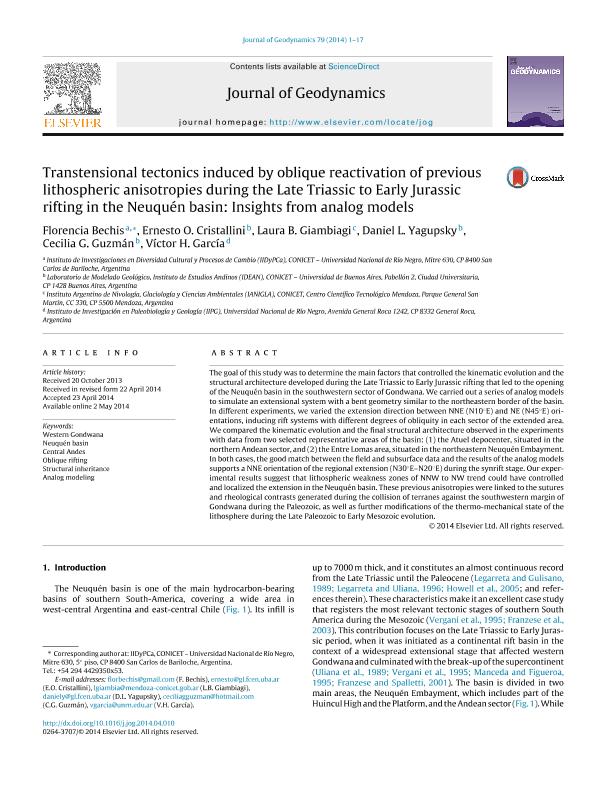Mostrar el registro sencillo del ítem
dc.contributor.author
Bechis, Florencia

dc.contributor.author
Cristallini, Ernesto Osvaldo

dc.contributor.author
Giambiagi, Laura Beatriz

dc.contributor.author
Yagupsky, Daniel Leonardo

dc.contributor.author
Guzman, Cecilia Griselda

dc.contributor.author
Garcia, Victor Hugo

dc.date.available
2016-12-19T19:34:18Z
dc.date.issued
2014-09
dc.identifier.citation
Bechis, Florencia; Cristallini, Ernesto Osvaldo; Giambiagi, Laura Beatriz; Yagupsky, Daniel Leonardo; Guzman, Cecilia Griselda; et al.; Transtensional tectonics induced by oblique reactivation of previous lithospheric anisotropies during the Late Triassic to Early Jurassic rifting in the Neuquén basin: Insights from analog models; Pergamon-Elsevier Science Ltd; Journal Of Geodynamics; 79; 9-2014; 1-17
dc.identifier.issn
0264-3707
dc.identifier.uri
http://hdl.handle.net/11336/9764
dc.description.abstract
The goal of this study was to determine the main factors that controlled the kinematic evolution and the structural architecture developed during the Late Triassic to Early Jurassic rifting that led to the opening of the Neuquén basin in the southwestern sector of Gondwana. We carried out a series of analog models to simulate an extensional system with a bent geometry similar to the northeastern border of the basin. In different experiments, we varied the extension direction between NNE (N10◦E) and NE (N45◦E) orientations, inducing rift systems with different degrees of obliquity in each sector of the extended area. We compared the kinematic evolution and the final structural architecture observed in the experiments with data from two selected representative areas of the basin: (1) the Atuel depocenter, situated in the northern Andean sector, and (2) the Entre Lomas area, situated in the northeastern Neuquén Embayment. In both cases, the good match between the field and subsurface data and the results of the analog models supports a NNE orientation of the regional extension (N30◦E–N20◦E) during the synrift stage. Our experimental results suggest that lithospheric weakness zones of NNW to NW trend could have controlled and localized the extension in the Neuquén basin. These previous anisotropies were linked to the sutures and rheological contrasts generated during the collision of terranes against the southwestern margin of Gondwana during the Paleozoic, as well as further modifications of the thermo-mechanical state of the lithosphere during the Late Paleozoic to Early Mesozoic evolution.
dc.format
application/pdf
dc.language.iso
eng
dc.publisher
Pergamon-Elsevier Science Ltd

dc.rights
info:eu-repo/semantics/openAccess
dc.rights.uri
https://creativecommons.org/licenses/by-nc-sa/2.5/ar/
dc.subject
Western Gondwana
dc.subject
Neuquén Basin
dc.subject
Central Andes
dc.subject
Oblique Rifting
dc.subject
Structural Inheritance
dc.subject
Analog Modeling
dc.subject.classification
Geología

dc.subject.classification
Ciencias de la Tierra y relacionadas con el Medio Ambiente

dc.subject.classification
CIENCIAS NATURALES Y EXACTAS

dc.title
Transtensional tectonics induced by oblique reactivation of previous lithospheric anisotropies during the Late Triassic to Early Jurassic rifting in the Neuquén basin: Insights from analog models
dc.type
info:eu-repo/semantics/article
dc.type
info:ar-repo/semantics/artículo
dc.type
info:eu-repo/semantics/publishedVersion
dc.date.updated
2016-12-12T14:23:47Z
dc.journal.volume
79
dc.journal.pagination
1-17
dc.journal.pais
Estados Unidos

dc.journal.ciudad
Ámsterdam
dc.description.fil
Fil: Bechis, Florencia. Consejo Nacional de Investigaciones Científicas y Técnicas. Centro Científico Tecnológico Patagonia Norte. Instituto de Investigaciones En Diversidad Cultural y Procesos de Cambio; Argentina
dc.description.fil
Fil: Cristallini, Ernesto Osvaldo. Universidad de Buenos Aires. Facultad de Cs.exactas y Naturales. Departamento de Geologia. Laboratorio de Modelado Geologico; Argentina. Consejo Nacional de Investigaciones Científicas y Técnicas; Argentina. Universidad de Buenos Aires. Facultad de Ciencias Exactas y Naturales. Departamento de Ciencias Geologicas. Instituto de Estudios Andinos "Don Pablo Groeber"; Argentina
dc.description.fil
Fil: Giambiagi, Laura Beatriz. Consejo Nacional de Investigaciones Científicas y Técnicas. Científico Tecnológico Mendoza. Instituto Argentino de Nivología, Glaciología y Ciencias Ambientales; Argentina
dc.description.fil
Fil: Yagupsky, Daniel Leonardo. Universidad de Buenos Aires. Facultad de Cs.exactas y Naturales. Departamento de Geologia. Laboratorio de Modelado Geologico; Argentina. Consejo Nacional de Investigaciones Científicas y Técnicas; Argentina. Universidad de Buenos Aires. Facultad de Ciencias Exactas y Naturales. Departamento de Ciencias Geologicas. Instituto de Estudios Andinos "Don Pablo Groeber"; Argentina
dc.description.fil
Fil: Guzman, Cecilia Griselda. Universidad de Buenos Aires. Facultad de Cs.exactas y Naturales. Departamento de Geologia. Laboratorio de Modelado Geologico; Argentina. Universidad de Buenos Aires. Facultad de Ciencias Exactas y Naturales. Departamento de Ciencias Geologicas. Instituto de Estudios Andinos "Don Pablo Groeber"; Argentina. Consejo Nacional de Investigaciones Científicas y Técnicas; Argentina
dc.description.fil
Fil: Garcia, Victor Hugo. Consejo Nacional de Investigaciones Científicas y Técnicas; Argentina. Universidad Nacional de Rio Negro. Sede Alto Valle. Instituto de Investigaciones en Paleobiologia y Geologia; Argentina
dc.journal.title
Journal Of Geodynamics

dc.relation.alternativeid
info:eu-repo/semantics/altIdentifier/url/http://www.sciencedirect.com/science/article/pii/S026437071400060X
dc.relation.alternativeid
info:eu-repo/semantics/altIdentifier/doi/http://dx.doi.org/10.1016/j.jog.2014.04.010
Archivos asociados
